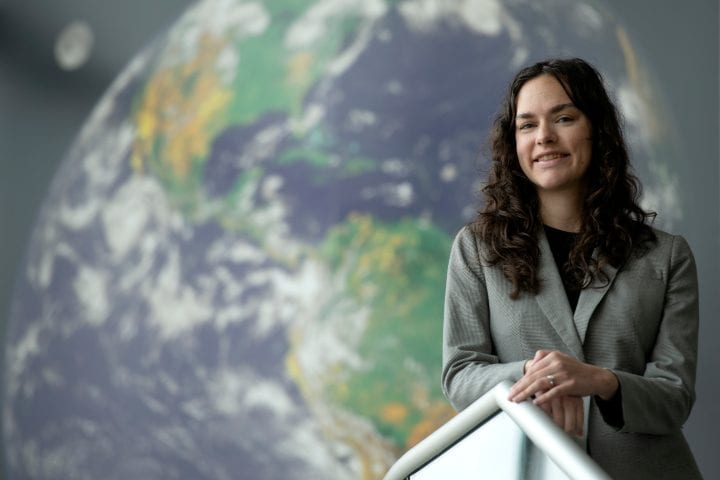UC Irvine scientists develop freely available risk model for hurricanes, tropical cyclones

Jane Baldwin, UC Irvine professor of Earth system science, says, “Tropical cyclones are some of the most impactful natural disasters on Earth. They pose huge risks to both human life and the built environment, so they have large economic costs associated with them and cause a lot of deaths. We need to be able to quantitatively explain their risk, meaning the probability of seeing different levels of losses.”
Irvine, Calif., June 27, 2023 — As human-driven climate change amplifies natural disasters, hurricanes and typhoons stand to increase in intensity. Until now, there existed very few freely available computer models designed to estimate the economic costs of such events, but a team of researchers led by Jane W. Baldwin at the University of California, Irvine recently announced the completion of an open-source model that stands to help countries with high tropical cyclone risks better calculate just how much those storms will impact their people and their economies.
“Tropical cyclones are some of the most impactful natural disasters on Earth. They pose huge risks to both human life and the built environment, so they have large economic costs associated with them and cause a lot of deaths,” said Baldwin, a professor in the UCI Department of Earth System Science and the lead author of the new paper in the American Meteorological Society journal Weather, Climate, and Society. “We need to be able to quantitatively explain their risk, meaning the probability of seeing different levels of losses.”
The economic risk model the team built extends an existing global tropical cyclone model, called the “Columbia tropical cyclone hazard” model. The economic risk model is prototyped for the Philippines but is straightforwardly customizable to any part of the world where stakeholders want to understand the storm risks they face.
Storms are called hurricanes when they form over the North Atlantic, typhoons when they form over the Northwest Pacific, and tropical cyclones when they form over in the Indian Ocean or South Pacific.
The benefit of the new model is that countries that may not be able to afford access to other such risk models and associated vulnerability data, which typically belong to for-profit insurance companies that do not freely share their products or data, can get a clearer picture of the risks they face.
“That’s a strong motivation of the work, to expand the accessibility of tropical cyclone risk information,” said Baldwin.
It’s one reason why the country the team used as a case study in their research was the Philippines. That country, according to the researchers, faces among the highest number of landfalling tropical cyclones on Earth in any given year, but it is relatively less equipped when it comes to gauging the losses it may incur as a result.
The new model is unique in that it combines data from two disparate fields: climate change science from experts like Baldwin, and household vulnerability information acquired from data from the World Bank.
“Connecting these data is useful for people-focused disaster preparedness and response,” said Brian Walsh, an economist with the World Bank and an author on the new study. “That means rapid assistance to needful households, so that families can meet basic needs, children can return to schools, and communities can build back better.”
“What the model gives is return periods of asset losses, so that means total dollars lost from storms across different regions in the Philippines at different probabilities, at different levels of rarity,” said Baldwin. “There’s a pretty strong understanding that the strongest tropical cyclones should become more intense going into the future. But there’s still a lot of disagreement about how you go from that understanding to estimates of risk on the ground that are usable and help people constrain their adaptation needs.”
Beyond forecasting the monetary costs, the model can also help countries and even certain large municipalities to better prepare for a tropical cyclone by allowing them to understand exactly where they should spend time and resources preparing for such disasters.
“There’s a growing need to be able to merge information from academic fields like climate science and these more applied risk modeling enterprises,” said Baldwin. “It’s a burgeoning field that I’m hoping will continue to develop over the next few years of catastrophe modeling as an academic enterprise and not just as a private enterprise. And I think climate change is really pushing the need for that dialogue.”
Joining Baldwin for this project were researchers from Lamont-Doherty Earth Observatory in Palisades, New York; the World Bank in Washington, D.C.; and Columbia University in New York.
About UCI’s Brilliant Future campaign: Publicly launched on Oct. 4, 2019, the Brilliant Future campaign aims to raise awareness and support for UCI. By engaging 75,000 alumni and garnering $2 billion in philanthropic investment, UCI seeks to reach new heights of excellence in student success, health and wellness, research and more. The School of Physical Sciences plays a vital role in the success of the campaign. Learn more by visiting https://brilliantfuture.uci.edu/uci-school-of-physical-sciences/.
About the University of California, Irvine: Founded in 1965, UCI is a member of the prestigious Association of American Universities and is ranked among the nation’s top 10 public universities by U.S. News & World Report. The campus has produced five Nobel laureates and is known for its academic achievement, premier research, innovation, and anteater mascot. Led by Chancellor Howard Gillman, UCI has more than 36,000 students and offers 224-degree programs. It’s located in one of the world’s safest and most economically vibrant communities and is Orange County’s second-largest employer, contributing $7 billion annually to the local economy and $8 billion statewide. For more on UCI, visit www.uci.edu.
Media access: Radio programs/stations may, for a fee, use an on-campus ISDN line to interview UCI faculty and experts, subject to availability and university approval. For more UCI news, visit news.uci.edu. Additional resources for journalists may be found at communications.uci.edu/for-journalists.
